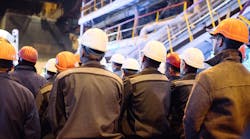“We’re just getting started.”
That was the full text of a recent statement from the UAW’s newly elected President, Shawn Fain, announcing (via the subject line) that the UAW added 10,000 new members in 2022.
Fain’s statement is representative of the optimistic attitude of labor organizers throughout the United States today and some notable increases in union activity across the country. According to a Gallup poll published late last year, popular support for unions in the U.S. is at 71%, its highest point since 1965. The NLRB announced April 7 that agency filings against unfair labor practices and petitions to form unions had both increased in both the last six months and in the past few years. The signs point towards a current surge of energy among labor organizers.
Despite all that, according to the Department of Labor’s latest release on union participation, the percentage of workers in public and private unions actually dipped to the lowest rate on record in last year—10.1%, according to the Bureau of Labor Statistics’ January 2023 report. Complicating things is that the number of people participating in unions did rise in 2022—1.9% more people than in 2021. The organized labor participation rate fell because it didn’t manage to keep pace with the amount of non-union workers hired, which rose by 3.9%.
According to Mekesha Montgomery, a labor and employment attorney with a 24-year record working on negotiations on cases for and against unions, including discrimination claims, the current labor environment is just the latest swing of the pendulum as it swings away from the Trump era.
“The message that is out there about unions and what they do swings wildly between administrations,” Montgomery said. Three out of four board members of the NLRB—including the board’s chair, Lauren McFerran—were appointed by President Biden. Board members appointed by a sitting president “tend to identify strongly with whatever the president’s leaning is,” said Montgomery, leading members of the public who see the NLRB as experts to sway towards or away from the sitting president’s own stance.
Join Montgomery and IndustryWeek editors on Thursday, April 13, at 2 p.m. (EDT) for a conversation about how much federal regulators across several agencies are favoring workers over employers.
Drawing on that understanding of the NLRB and its public perception, Montgomery doubts that the current swaying of labor policies will be necessarily a long-term one—though it is a movement current employers should be aware of, especially union-skeptical employers.
“You’ve got increased general popularity alongside a very favorable board environment,” Montgomery said. “So if you do not want a union, it is something you better be paying attention to right now, because the environment is perfect for you to get one whether you like it or not.”
Two specific cases for employers to be aware of are what Montgomery calls “micro-unions” as well as faster turnaround for unionization votes. In the first case, specialized groups of workers in a business may decide to unionize independently of the rest of the business.
“It’s much easier to win [a vote to form a union] when you have a smaller voting block because you have the ability to have one-on-one conversations with each one of the folks who would be in there, as opposed to hoping that your message is getting across to a much broader group. So, for example, if you have a facility that’s got 1,500 employees, and 200 of them are mechanics and 1,300 of them are production employees, it’s much easier to go in and target that group of 200 [mechanics],” she said.
Despite all the policy energy from the NLRB, though, Montgomery was skeptical that the latest pendulum swing would change much in terms of manufacturing unionization, predicting it would “stay steady, if not decline.”
To back up her claim, she identified two trends that may offset the effects of a union-positive NLRB. The first is that the makeup of manufacturing companies themselves are changing, and the second is that larger pushes to unionize workforces are focused mainly outside of manufacturing.
“Manufacturing jobs have changed so much that we have more folks coming in as engineers, right? They’re in a different group than purely production [workers],” she said. “You’re getting a change in the types of employees, and a lot of those folks are not going to be in the bargaining unit in a manufacturing facility.”
Secondly, Montgomery notes that a lot of the movement in organized labor right now is happening outside of manufacturing, in the service and shipping industries, as demonstrated by ongoing movements to unionize companies like Starbucks and Amazon warehouses.
“We’re getting the unions focusing away from their traditional manufacturing strongholds into these other areas,” she predicted. “They’re just at the beginning of it.”




